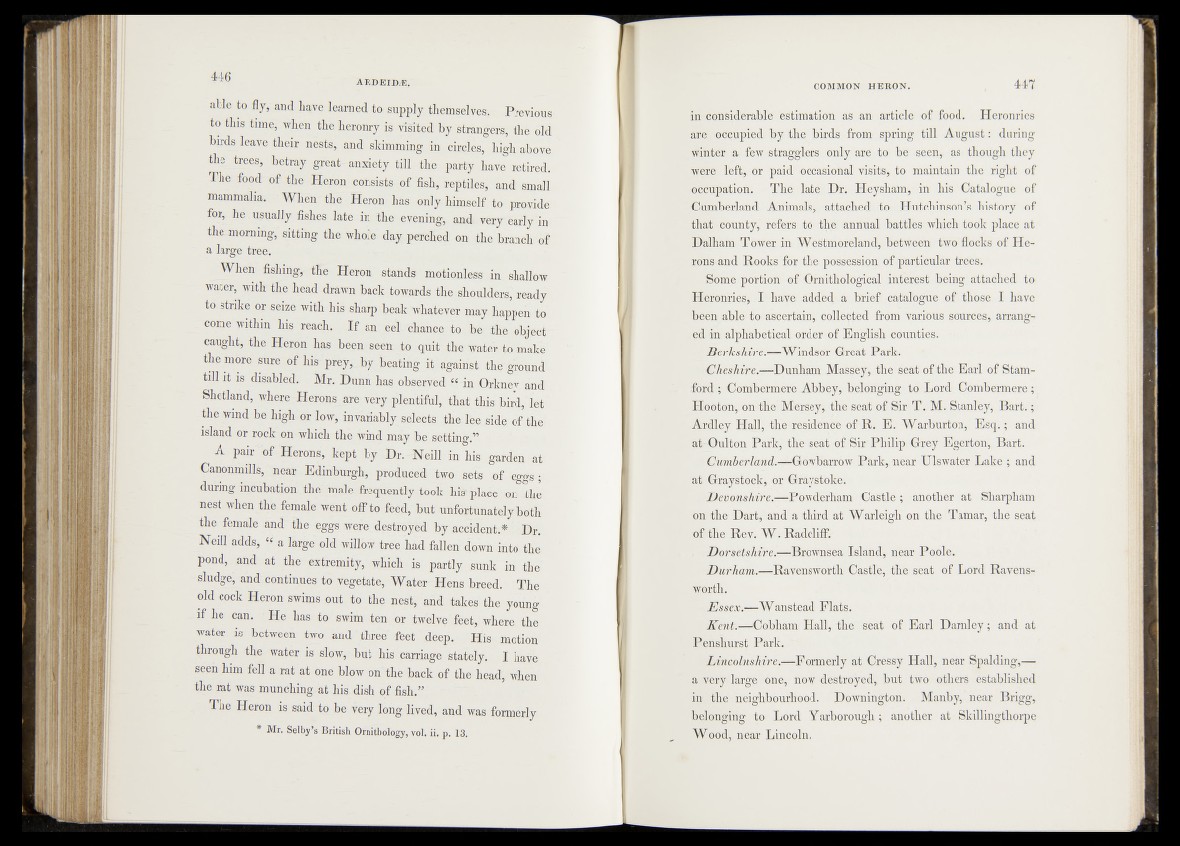
à r d e id æ .
able to fly, and have learned to supply themselves, Previous
to this time, when the heronry is posited by strangers; the old
birds leave their nests, and skimming in circles, high above
the trees, betray great-anxiety, till the party have retired.
The food- of the Heron consists o§< fish, reptiles, and small
mammalia. When the Heron has only, himself to provide
for, he.usually fishes late in the evening, and very early in
the-morning, sitting the whole day perched on the branch of
a large tree.
When fishing,- the Heron stands motionless in shallow
waten with the head drawn back towards the shoulders,' ready
to strike or seize with his sharp beak whatever may happen to f
: come within his reach. I f an eel chance to be the ^object'
caught, the Henan has been-seen ;fre quit’the water to -make
the more sure of Lis'prey, by beating it ’agaih'st the“ground
till it is disabled. Mr. Dunn has observed gdn Qrknfey/and
Shetland, where Herons^ are very plentiful, that this bird,*let
the wind be high er low, invariably selects the-lbe side df-thef
island or rock^on which the wind may be S'Sttifig,,i: ^
-A p a u -V Herons, k e p tb y D r .-N e illin his garden at
Canonmills, near Edinburgh, produced two sets df 'eggs-yi
during incubation the'male frequently took bii^plaee "on the“
nest when the female went off to feCfl, bu t unfortunately: both
the. female and the ,eggs were destroyed by .accident.* Dr.
Neill adds, * a large old willow tree had fallen down into‘4he
pond, and at the-rntremity, which is partly sunk*“ in the
sludge, and continues to vegetate, Water- Hens breed. The
old cock Heron swims out to the nest, and takes the yoiing
if he ean. He has to swim ten or twelve feet, where the
water is: between two and .three feet deep. His motion
through the water is slow, but his' carriage stately. I have
seen him fell a rat at one blow on the back of the head, when
the rat was munching-at his, dish of fish.”
The Heron is said to be very long lived, and was formerly
* Mr. Selby’s British Ornithology, vol. fi, p. 13.
COMMON HERON. 447
in considerable estimation as an article of food. Heronries
are occupied by the birds from spring till August: during
winter a few stragglers only are to be seen, as though they
were left, or paid occasional visits, to maintain the right of
occupation. The late Dr. Heysham, in his Catalogue of
Cumberland Animals, attached to Hutchinson’s history of
that ©btmty, refers to the annual battles which took place at
DaJham Tower in Westmoreland, between two flocks of He-
,rons-and Rooks for the possession of particular trees,
Some portion of; Ornithological interest being attached to
Heronries, I have added a brief catalogue of those I have
,bieen//able!'to ascertain, collected from various sources, arrange
ed in alphabetical, order of English counties.' . -1
Berkshire.-—Windsor Great Park.
• Cheshire.—Dunham Massey, the seat of the Earl of Stamford
; Combermere Abbey, belonging to Lord. Combermere;
Hebton, on the Mersey, the seat of Sir T. M. Stanley, Ba rt.;
Ardley Hall, the .residence of R. E. Warburton, E sq .; and
at~Oulton Park, the-seat of. S ir Philip Grey Egerton, Bart.
!m0nmberland.—Gowbarrow Park, near Ulswater Lake ; and
at Graystock, or Grhysfoke.
Det>owsA*re,^Powderham Castle; another;at Sharpham
on the Dart, and a third at Warleigh on the Tamar, the seat
o f the Rev. W . Radcliffj-
, Dorsetshire.-—Brownsea Island, near Poole.
Durham.—Ravenswortk Castle, the seat of Lord Ravens*
worth.
- Essex.—Wanstead Flats.
Kent.—Cobham Hall, the seat of Earl Damley; and at
Penshurst Park.
Lincolnshire.—Formerly at Cressy Hall, near Spalding,—
a-.Very large one, now destroyed,, but two others established
in the neighbourhood. Downington. Manby, near Brigg,
belonging to Lord Yarborough; another at Skillingthorpe
Wood, near Lincoln.